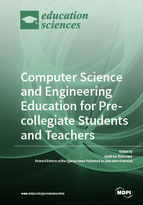Computer Science and Engineering Education for Pre-collegiate Students and Teachers
A special issue of Education Sciences (ISSN 2227-7102).
Deadline for manuscript submissions: closed (31 January 2019) | Viewed by 30593
Special Issue Editor
Interests: science education; STEM integration; teaching and learning partnerships; teaching; pedagogy and education; professional development; teacher training; curriculum development; pedagogy; collaborative learning; teaching experience
Special Issues, Collections and Topics in MDPI journals
Special Issue Information
Dear Colleagues,
There are widespread areas to explore in both engineering education and computer science education. While computer science has roots in mathematics and is often seen as a branch of engineering, based on Johri and Olds’ Cambridge Handbook of Engineering Education Research (2014) and Kadijevich, Angeli, and Schulte's Improving Computer Science Education (2013), exploration of computer science and engineering education offers a rich field of study.
This Special Issue “Computer Science and Engineering Education for Pre-Collegiate Students and Teachers” is a mechanism to advance and capture the current conversation about computer science and engineering education in pre-collegiate schools—worldwide—by using current research studies in the area. Quantitative, qualitative, mixed methods, and action research methodologies are welcome for this special issue. A clear problem and research questions, appropriate theoretical framework, literature review, methodology and methods, analysis, conclusions, and limitations are expected for all submitted articles.
Additionally, there are many resources that this special issue could highlight and bring to the forefront of computer science education. Authors of potential articles should consider including a successful lesson or professional development activity as exemplars of “ideas to try”. A special issue in computer science and engineering education also warrants connection to other disciplines (science, technology, engineering, mathematics, among others) in order to highlight how current teachers (and students) can enhance what they are already considering or implementing in pre-collegiate classrooms (that might even seem distant from these research areas). Engineering, technology, and computer science standards from states, countries, and organizations are welcome and encouraged as a piece of the research studies as well.
Questions to consider when writing about pre-collegiate computer science and engineering research studies: (1) What courses are offered at the pre-collegiate level in computer science and/or engineering in the geographic area of the study? (2) Are the courses offered in isolation or combined with another subject? (3) Who (teacher and/or student) has access to the computer science and engineering courses? (4) What approaches are used in the computer science and engineering courses? (5) What professional development learning opportunities are available for teachers delivering computer science and engineering course content? (6) What standards do teachers and students use in computer science and engineering courses? (7) What is needed to move pre-collegiate computer science and engineering education forward as a field? (8) What collaborative partnerships have enabled successful adoption of computer science and engineering education in pre-collegiate environments? and (9) other questions related to context, successes, and challenges in pre-collegiate computer science and engineering education.
Finally, consider this: How close are we—as a worldwide community—to the vision set forth for 2020 in Greening’s Computer Science Education in the 21st Century (2000)?
Dr. Andrea BurrowsGuest Editor
Manuscript Submission Information
Manuscripts should be submitted online at www.mdpi.com by registering and logging in to this website. Once you are registered, click here to go to the submission form. Manuscripts can be submitted until the deadline. All papers will be peer-reviewed. Accepted papers will be published continuously in the journal (as soon as accepted) and will be listed together on the special issue website. Research articles, review articles as well as short communications are invited. For planned papers, a title and short abstract (about 100 words) can be sent to the Editorial Office for announcement on this website.
Submitted manuscripts should not have been published previously, nor be under consideration for publication elsewhere (except conference proceedings papers). All manuscripts are thoroughly refereed through a double-blind peer-review process. A guide for authors and other relevant information for submission of manuscripts is available on the Instructions for Authors page. Education Sciences is an international peer-reviewed open access monthly journal published by MDPI.
Please visit the Instructions for Authors page before submitting a manuscript. Submitted papers should be well formatted and use good English. Authors may use MDPI's English editing service prior to publication or during author revisions.
Keywords
- engineering education
- computer science
- pre-collegiate teachers
- pre-collegiate students
- K-12, NGSS






